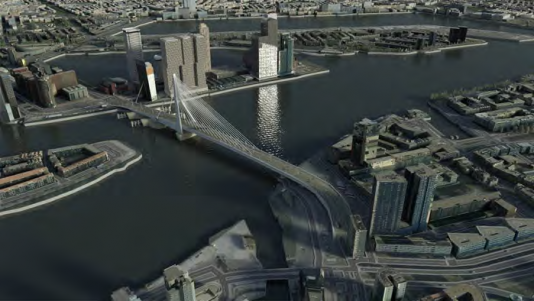The newest ArcGIS add-on is getting easier to use and more appealing for city planners and architects alike.
By Marilyn Novell
Esri’s CityEngine addition to ArcGIS was showcased at Siggraph, and it is impressive. CityEngine enables the quick creation of 3D urban environments out of 2D data. But beyond that, it can take existing 3D models or real-world information in a variety of file formats, incorporate the information into an urban scenario, and manipulate the scene using real-world or fantasy-world procedural instructions. Then any of the data can be output to view on the web or repurposed in multiple formats.

Esri effectively illustrated CityEngine’s capability of expanding 2D data to an imaginary 3D environment by using a curious attendee’s thumbprint to extrude a convincing city-like environment in no time (in the demo anyway). CityEngine’s flexibility in the real world and beyond comes with its compatibility with multiple standard file formats, including Collada, Renderman, Google Earth, SketchUp, Wavefront, 3DS, Autodesk FBX, and WebGL. The software’s pragmatic side is in its power to analyze and plan large-scale urban development as suggested by its online interface including a toggling function of as built/proposed and import/export support for hard geospatial data. Its intuitive interface and ease of downscaling resolution and level of detail when needed allows viewing of scenarios on the fly.
CityEngine began as a procedural tool (and in fact, the original company was called Procedural) developed in a 1999 thesis by Zurich-based Pascal Mueller. In what appears to be a smart move, Esri acquired CityEngine from Procedural last year and integrated it with its ArcGIS geodata system. The company is keeping CityEngine as a stand-alone product for use in architecture, city planning and development, movies and games, and GIS. What CityEngine brings to ArcGIS is a more complex, easily manipulated rule-based 3D modeling tool, and what ArcGIS brings to CityEngine is the power to visualize geospatial data.
City planners and designers will use it, as will architects and developers. CityEngine speaks the language of city planners with savvy capabilities such as the ability to apply a procedural TOD (transit oriented development) and to automatically constrict the 3D model by incorporating building regulations such as setbacks and heights, street widths, and zoning requirements. What’s smart about CityEngine is that it can also take existing data such as parcel information and building footprints and plug it all into the final scenario. 3D models of buildings like those people build for Google Earth with SketchUp can be added too.
Esri is making architects happy with features like a set of architectural styles that can be applied to buildings and easily changed, and it is making historians happy by matching those styles with dates which can be changed by moving a slider along a scale. So the eager city-builder can look at the 2012 model of Paris and run a slider back to, say, 1878, and get an idea how the city might have looked with a different set of façade features.
Developers will use CityEngine’s analytical features to, for example, identify the potential for development by comparing real-world sites with their maximum exploitation based on current building regulations.
CityEngine has been used to efficiently build 3D models of cities for movies such as Disney’s Prince of Persia: The Sands of Time. According to Esri, Pixar used the software for a flythrough of London in Cars 2. Clearly, virtual environments for games are another obvious application.
The real world applies
At Siggraph, Esri showed case studies of Philadelphia and Paris. Also, working with the city of Rotterdam and Mental Images, Esri built a model of Rotterdam—an online visualization that gives everyone access to the model.
With the upcoming release of CityEngine 2012, Esri will let us see what they have been working on for the city of Redlands, California, Esri’s home base. Redlands is a politically slow-growth, smallish city (70K) that is using its existing GIS data as well as ongoing lidar scans and stereoscopic imaging to build a 3D model of the downtown area. Additionally, the rule-based capabilities of CityEngine are being used to visualize proposed concentrations of development. Redlands’ GIS supervisor Philip Mielke says they hope to involve residents in decisions about centralized transit-oriented development and to overcome resistance to building sometimes larger, taller, LEED-certified buildings to avoid the sprawl of neighboring areas. One way Esri is helping smaller cities acquire the technology is by basing licensing fees on population.
The version on display at Siggraph was CityEngine 2011, and Esri is planning to launch an update in September that will streamline some of the features, including the sometimes steep learning curve for directly manipulating the CityEngine code. The big news is that since Esri acquired CityEngine and integrated it into ArcGIS, both systems are the better for it. It is a happy marriage that appears headed for a long run.
Marilyn Novell is managing editor of Jon Peddie TechWatch.





